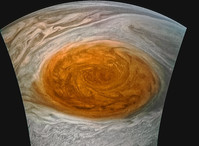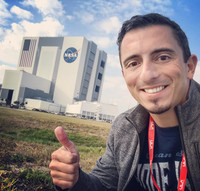An unprecedented visual portrayal of our spectacular, distant neighbor, Jupiter, is now available to everyone on Earth with an internet connection, thanks to a talented Warwick graphic designer (and maybe some help from NASA).
This item is available in full to subscribers.
We have recently launched a new and improved website. To continue reading, you will need to either log into your subscriber account, or purchase a new subscription.
If you are a current print subscriber, you can set up a free website account by clicking here.
Otherwise, click here to view your options for subscribing.
Please log in to continue |
|



An unprecedented visual portrayal of our spectacular, distant neighbor, Jupiter, is now available to everyone on Earth with an internet connection, thanks to one talented Warwick graphic designer who has a passion for making the wonders of the cosmos visibly accessible for all to appreciate.
“Space is our final frontier,” said Jason Major, a Warwick native and self-employed graphic designer who helps process raw images taken by NASA. “Space is where we live. Yes we live in our homes and our offices and we live here on Earth, but space is our neighborhood. It’s only an eight and a half minute ride upwards in our best rockets. It’s not that far away and there’s a lot of real places out there. That’s what excites me.”
Major is one of a handful of civilian scientists and artists who take huge, off-colored and often imperfect raw images uploaded from NASA’s space missions and process them, usually through editing software like Adobe Photoshop, to create remarkable depictions of our celestial surroundings.
NASA purposefully makes these raw images part of the public domain and allows enthusiasts, hobbyists and professionals, like Major, to do the heavy lifting when it comes to processing the photos. For NASA, it’s a win-win situation. They don’t need to expend the money or time to process the photos, and they get the best images for public relations they could ever hope for – all for no extra cost.
“We can do it a lot faster than they can. That’s why I think they appreciate our effort,” said Major. “It's almost like, ‘Okay guys, here’s the stuff. Now get to work.’”
The photo on the cover of this feature came from NASA’s Juno mission, which launched on Aug 5, 2011 from Cape Canaveral, Fla. (where Major was actually in attendance). The Juno spacecraft carries with it eight scientific instruments to study every different aspect of Jupiter imaginable – atmospheric conditions, magnetic and gravity fields, its northern and southern poles – in order to hopefully find out the origin and evolution of our Solar System’s biggest planet.
However the most important instrument Juno carries, in relation to Major, was an instrument that wasn’t even originally planned to be included – its camera.
“Juno is a public outreach mission,” said Major. “Without pictures it’s difficult to get the public interested in what [NASA] is doing.”
On July 10, Juno reached what is called “perijove,” the point in its orbit around Jupiter where the spacecraft was closest to the planet’s center. A little after 10 p.m. that same day (in Warwick time), Juno passed directly above, and closer than any spacecraft had ever been before, the notorious Great Red Spot – a massive atmospheric storm over 10,000 miles wide and 1.3 times the size of Earth which has possibly been raging for over 350 years, according to NASA.
The images that were snapped have since been processed by many different artists and hobbyists into many different styles. However Major’s image, a tightened, true color image of one of the most iconic features of our Solar System, was one of the first to be finished when the raw files emerged the following Wednesday. It remains to be featured on news outlets across the globe, and on NASA’s own article describing the Juno mission.
“These highly-anticipated images of Jupiter’s Great Red Spot are the ‘perfect storm’ of art and science. With data from Voyager, Galileo, New Horizons, Hubble and now Juno, we have a better understanding of the composition and evolution of this iconic feature,” said Jim Green, NASA’s director of planetary science, in a statement. “We are pleased to share the beauty and excitement of space science with everyone.”
Although Major has a personal connection to Juno, and has seen plenty of exposure due to his work on its images, he has been processing these types of open source images from NASA since 2009, when he started his blog, LightsintheDark.com, showcasing his work and writing educational posts about outer space.
Major first made headlines in Warwick by sharing the wonders of space with residents of Pawtuxet Village, where he brings a telescope that he won in a Twitter contest in order to show passersby on the bridge linking Cranston and Warwick a view of the full moon they have rarely, or never, seen before.
“I love sharing this type of stuff with people who are also excited about it or don’t know a lot about it and want to know more,” Major said. “To take something that might just be a paragraph in a school textbook and show it’s a real thing; that these places have weather, they have clouds and atmospheres. And that one day, people are going to be walking on the surfaces of some of these, it becomes real.”
“We have to do that, too, because eventually we will need to expand outwards from here,” he continued. “It may not be 10 years or even 100 years from now, but eventually we as a species are going to need to do that, so we need to learn about what’s out there.”
Comments
No comments on this item Please log in to comment by clicking here